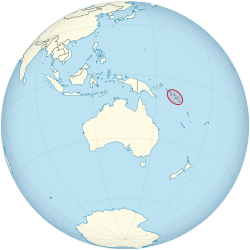Solomon Islands Solomon Aelan (Pijin) | |
|---|---|
| Motto: "To Lead is to Serve" | |
| Anthem: "God Save Our Solomon Islands"[1] | |
 | |
| Capital and largest city | Honiara 9°25′55″S 159°57′20″E / 9.43194°S 159.95556°E |
| Official languages | |
| Ethnic groups (2016) |
|
| Religion (2016)[2] |
|
| Demonym(s) | Solomon Islander Solomonese |
| Government | Unitary parliamentary constitutional monarchy |
• Monarch | Charles III |
| David Tiva Kapu | |
| Jeremiah Manele | |
| Legislature | National Parliament |
| Independence | |
• from the United Kingdom | 7 July 1978 |
| Area | |
• Total | 28,896[3] km2 (11,157 sq mi) (139th) |
• Water (%) | 3.2% |
| Population | |
• 2023 estimate | 734,887 (167th) |
• 2019 census | 721,956 |
• Density | 24.2/km2 (62.7/sq mi) (200th) |
| GDP (PPP) | 2024 estimate |
• Total | |
• Per capita | |
| GDP (nominal) | 2024 estimate |
• Total | |
• Per capita | |
| Gini (2013) | medium inequality |
| HDI (2022) | medium (156th) |
| Currency | Solomon Islands dollar (SBD) |
| Time zone | UTC+11 (Solomon Islands Time) |
• Summer (DST) | Solomon Islands does not have an associated daylight saving time |
| Drives on | left |
| Calling code | +677 |
| ISO 3166 code | SB |
| Internet TLD | .sb |
Solomon Islands,[7] also known simply as the Solomons,[8] is an island country consisting of six major islands and over 900 smaller islands in Melanesia, part of Oceania, to the northeast of Australia. It is directly adjacent to Papua New Guinea to the west, Australia to the southwest, New Caledonia and Vanuatu to the southeast, Fiji, Wallis and Futuna, and Tuvalu to the east, and Nauru and the Federated States of Micronesia to the north. It has a total area of 28,896 square kilometres (11,157 sq mi),[9] and a population of 734,887 according to the official estimates for mid 2023.[10] Its capital and largest city, Honiara, is located on the largest island, Guadalcanal. The country takes its name from the wider area of the Solomon Islands archipelago, which is a collection of Melanesian islands that also includes the Autonomous Region of Bougainville (currently a part of Papua New Guinea), but excludes the Santa Cruz Islands.
The islands have been settled since at least some time between 30,000 and 28,800 BC, with later waves of migrants, notably the Lapita people, mixing and producing the modern indigenous Solomon Islanders population. In 1568, the Spanish navigator Álvaro de Mendaña was the first European to visit them.[11] Though not named by Mendaña, it is believed that the islands were called "the Solomons" by those who later received word of his voyage and mapped his discovery.[12] Mendaña returned decades later, in 1595, and another Spanish expedition, led by Portuguese navigator Pedro Fernandes de Queirós, visited the Solomons in 1606.
In June 1893, Captain Herbert Gibson of HMS Curacoa declared the southern Solomon Islands a British protectorate.[13][14] During World War II, the Solomon Islands campaign (1942–1945) saw fierce fighting between the United States, British Imperial forces, and the Empire of Japan, including the Battle of Guadalcanal.
The official name of the then-British administration was changed from the "British Solomon Islands Protectorate" to "The Solomon Islands" in 1975, and self-government was achieved the following year. Independence was obtained, and the name changed to just "Solomon Islands" (without the definite article), in 1978. At independence, Solomon Islands became a constitutional monarchy. The King of Solomon Islands is Charles III, who is represented in the country by a governor-general appointed on the advice of the prime minister.
- ^ "National Parliament of Solomon Islands Daily Hansard: First Meeting – Eighth Session Tuesday 9th May 2006" (PDF). www.parliament.gov.sb. 2006. p. 12. Archived from the original (PDF) on 30 October 2012. Retrieved 3 January 2019.
- ^ "Religions in Solomon Islands | PEW-GRF". Archived from the original on 23 January 2014.
- ^ "Solomon Islands: Geography". CIA Factbook. Archived from the original on 22 October 2021. Retrieved 25 July 2023.
- ^ a b c d "World Economic Outlook database (Solomon Islands)". World Economic Outlook, April 2024. International Monetary Fund. April 2024. Archived from the original on 26 April 2024. Retrieved 26 April 2024.
- ^ "Gini Index coefficient". CIA World Factbook. Archived from the original on 17 July 2021. Retrieved 16 July 2021.
- ^ "HUMAN DEVELOPMENT REPORT 2023-24" (PDF). United Nations Development Programme. United Nations Development Programme. 13 March 2024. pp. 274–277. Archived (PDF) from the original on 1 May 2024. Retrieved 3 May 2024.
- ^ "Solomon Islands country brief". Archived from the original on 22 December 2022. Retrieved 22 December 2022.
- ^ John Prados, Islands of Destiny, Dutton Caliber, 2012, p,20 and passim
- ^ "Solomon Islands: Geography". CIA Factbook. Archived from the original on 22 October 2021. Retrieved 25 July 2023.
- ^ Solomon Islands National Statistical Office - estimate as at 1 July 2023.
- ^ "Alvaro de Mendaña de Neira, 1542?–1595". Princeton University Library. Archived from the original on 17 April 2019. Retrieved 8 February 2013.
- ^ "Alvaro de Mendan~a de Neira and Pedro Fernandes de Queirós". library.princeton.edu. Archived from the original on 9 August 2022. Retrieved 9 August 2022.
- ^ Lawrence, David Russell (October 2014). "Chapter 6 The British Solomon Islands Protectorate: Colonialism without capital" (PDF). The Naturalist and his "Beautiful Islands": Charles Morris Woodford in the Western Pacific. ANU Press. ISBN 9781925022032. Archived (PDF) from the original on 25 September 2022. Retrieved 30 March 2019.
- ^ Commonwealth and Colonial Law by Kenneth Roberts-Wray, London, Stevens, 1966. P. 897

